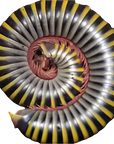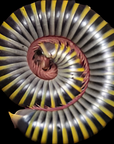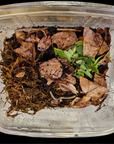


Bumblebee Millipede 'Florida' - Anadenobolus monilicornis
Not applicable with Auction Items
Defining Characteristics:
Great beginner bug
Easy to care For
Likes to burrow
Medium sized
Interesting
Good in groups
This is an INDIVIDUAL (1) Bumblebee Millipede!
Name: Florida Bumblebee Millipede - Anadenobolus monillicornis. This is a small, hardy, and very colorful millipede species.
Recommended Vivarium Size & Setup: Millipedes are easy to house. At minimum, you'll want the enclosure to be at least as wide as the animal's length, and at least twice as long. The more space provided, the better, as millipedes feed primarily on the substrate.
Plastic Critter Keepers or small aquaria work well—even plastic storage containers can be easily modified with some air holes and used as enclosures. The single most important thing about housing millipedes is their substrate. Substrate acts as a place for the millipede to dig, eat, hide, drink, and live in.
For a millipede, substrate = life. Substrates should consist of a mix of soil, wood, and leaves. We strongly recommend Josh's Frogs Milli Mix, as it's been formulated to provide your pet millipedes with a quality substrate. Bedding should be about 4-6 inches in depth, and kept moist at the bottom and allowed to very slightly dry out at the top.
Temperature (°F): 65-78° is a safe range. It's fine to keep your millipedes at room temperature. For most species, the low to mid 70s are ideal.
Supplemental heating in the form of a low wattage heat mat can be used if needed, but make sure that it doesn't dry out your millipede's habitat too quickly.
Humidity: Humidity is a very important aspect to millipede keeping. Millipedes will drink from standing water and can be provided with a small water bowl, but misting, providing a moist substrate, and providing fresh food will all help keep them hydrated as well.
Size: Bumblebee millipedes are a smaller species, maxing out at around 3 inches. These millipedes will be at least 1.5-2 inches when shipped from Josh's Frogs.
Age: Millipedes can live for several years in captivity under proper care.
Feeding: Millipedes will primarily feed on their substrate—they love decomposing wood and leaves! This should make up the bulk of their diet, making it necessary to change out spent substrate (which appears as little dirt balls) with fresh substrate on a regular basis.
You'll also want to provide the occasional fresh fruit or leafy greens, or diets such as Repashy Bug Burger, which provides a much-needed source of calcium.
Make sure to remove food that becomes moldy. Offering a bit of food once a week or so (in addition to their substrate) is plenty.
Sexing: Millipedes are much easier to sex than you may think. Count to the 7th body segment back from the head. If the legs look shorter/odd, you probably have a male on your hands! Males have external gonads (sex organs) instead of legs on their 7th segment.
Social Behavior: Millipedes do fine when housed in a group. They are not aggressive towards each other—just be sure to provide plenty of substrate, food, and hiding places.
Color/Pattern: This locale of bumblebee millipede is black with striping that generally starts yellow but turns to a bright white/pale gray halfway down.
Breeding: Millipedes will breed readily in well set up colonies or enclosures. Just leave a male and a female together, and chances are you'll eventually find baby millipedes crawling around in the substrate.
Leave the offspring in with their parents—you don't need to be concerned about cannibalism.
Natural Range: Bumblebee millipedes are native to Jamaica and the Caribbean, but have become naturalized in Florida.
Interesting Information:
Remember that millipedes are toxic—never allow young children to handle them unsupervised! As long as millipedes are not eaten and hands are washed after touching millipedes, they're virtually harmless.
Many species will spit up a bit if startled—this can easily dye your skin and take several days to fade.
Millipedes commonly host symbiotic mites that help keep the millipede clean. These mites live on the millipede and eat waste or bits of food that can become caught in the millipede's legs. These mites are harmless, so do not be concerned if you see some!
When shipping live animals, 24 shipping is required for almost all. Shipping may be adjusted by AO due to holidays, weather conditions, or customer confirmation to be available.
If you successfully win an auction item, you will receive an email to confirm awarded auctions. Your payment request will also be in your login profile and an email as well.
Learn more about AO
Aquatic Oasis has a in store club that will soon be available to online subscribers as well. Stay tuned for details of the AO Aquatics Club coming soon. Register your email below to receive future information on AO Aquatics Club ONLINE




